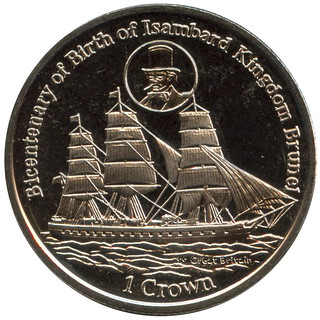
PREV ARTICLE
NEXT ARTICLE
FULL ISSUE
PREV FULL ISSUE
FATHER AND SON: THE ENGINEERS BRUNEL
Yossi Dotan submitted the following thoughts on father and son engineers Marc Isambard Brunel and Isambard Kingdom Brunel. Thanks!
-Editor
In The E-Sylum of June 26 there was an item about the portrait on the new British bank note of Winston Churchill, No. 1 in the poll of the Greatest Britons. In this context, Joe Esposito wrote: "It is surprising that Brunel, who is largely unknown in the United States, was number two. Brunel was a great engineer, whose work included the Thames River Tunnel. When completed in 1843, the tunnel was hailed as a marvel, and a number of medals were struck to commemorate it." The Brunel of the Thames River Tunnel was Marc Isambard Brunel (1769-1849). However, the Brunel who was No. 2 in the poll of the Greatest Britons was Marc's son, Isambard Kingdom Brunel (1806-1859). Isambard Kingdom Brunel is considered one of the most innovative and prolific engineers of his time. He designed three famous ships—Great Western (1837), the first purpose-built transatlantic steamship; Great Britain (1843), which at the time was the largest steamer ever made and the first iron, screw-propeller driven vessel built as a transatlantic liner; and Leviathan (1858), later renamed Great Eastern, which at the time of construction was six times larger than any previous ship in the world. Brunel Junior also designed roads, 125 bridges, 25 railway lines with over 1,000 miles of track, numerous docks and piers, and the first prefabricated military hospital. Isambard Kingdom Brunel and/or one of his famous ships are commemorated on coins of Gibraltar, the Falkland islands, Liberia, and Tuvalu. I attach the image of one of the three coins issued by the Falkland Islands which depicts the Great Britain and a medallion portrait of Brunel.
To read the earlier E-Sylum article, see:
Wayne Homren, Editor The Numismatic Bibliomania Society is a non-profit organization promoting numismatic literature. See our web site at coinbooks.org. To submit items for publication in The E-Sylum, write to the Editor at this address: whomren@gmail.com To subscribe go to: https://my.binhost.com/lists/listinfo/esylum All Rights Reserved. NBS Home Page Contact the NBS webmaster 
|
